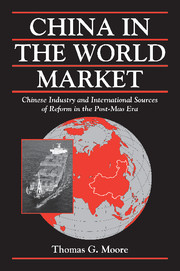Book contents
- Frontmatter
- Contents
- List of Figures
- List of Abbreviations
- Preface
- 1 China as a Latecomer in World Industrial Markets
- 2 The Outside World as an Impetus for Change in China
- 3 Tailor to the World: China's Emergence as a Global Power in Textiles
- 4 Beating the System with Industrial Restructuring: China's Response to the Multifiber Arrangement (MFA)
- 5 China Looms Large: Reform and Rationalization in the Textile Industry
- 6 Industrial Change in the Shadow of the MFA: The Role of Top-Level Strategy, Mid-Level Intervention, and Low-Level Demand in China's Textile Industry
- 7 Chinese Shipbuilding: The Modest Origins of an Emerging Industrial Giant
- 8 Dangerous Currents: Navigating Boom and Bust Cycles in International Shipbuilding
- 9 Chinese Shipbuilding and Global Surplus Capacity: Making a Virtue out of Necessity
- 10 Market-Oriented Solutions for Industrial Adjustment: The Changing Pattern of State Intervention in Chinese Shipbuilding
- 11 Who Did What to Whom?: Making Sense of the Reform Process in China's Shipbuilding Industry
- 12 External Shocks, State Capacity, and National Responses for Economic Adjustment: Explaining Industrial Change in China
- 13 China in the Contemporary International Political Economy
- Appendix Contours of the Research Effort
- Bibliography
- Index
7 - Chinese Shipbuilding: The Modest Origins of an Emerging Industrial Giant
Published online by Cambridge University Press: 07 August 2009
- Frontmatter
- Contents
- List of Figures
- List of Abbreviations
- Preface
- 1 China as a Latecomer in World Industrial Markets
- 2 The Outside World as an Impetus for Change in China
- 3 Tailor to the World: China's Emergence as a Global Power in Textiles
- 4 Beating the System with Industrial Restructuring: China's Response to the Multifiber Arrangement (MFA)
- 5 China Looms Large: Reform and Rationalization in the Textile Industry
- 6 Industrial Change in the Shadow of the MFA: The Role of Top-Level Strategy, Mid-Level Intervention, and Low-Level Demand in China's Textile Industry
- 7 Chinese Shipbuilding: The Modest Origins of an Emerging Industrial Giant
- 8 Dangerous Currents: Navigating Boom and Bust Cycles in International Shipbuilding
- 9 Chinese Shipbuilding and Global Surplus Capacity: Making a Virtue out of Necessity
- 10 Market-Oriented Solutions for Industrial Adjustment: The Changing Pattern of State Intervention in Chinese Shipbuilding
- 11 Who Did What to Whom?: Making Sense of the Reform Process in China's Shipbuilding Industry
- 12 External Shocks, State Capacity, and National Responses for Economic Adjustment: Explaining Industrial Change in China
- 13 China in the Contemporary International Political Economy
- Appendix Contours of the Research Effort
- Bibliography
- Index
Summary
BEHEMOTHS IN THE MAKING?: CHINA'S SHIPYARDS ON THE RISE
In the space of a single decade, from the early 1980s to the early 1990s, the Chinese shipbuilding industry was transformed from a technologically backward, poor-quality manufacturer of basic ships to a bona fide force in the world industry. Although Japan and South Korea still far outclassed the rest of the field, China had risen by the early 1990s to a position atop the middle-ranking shipbuilding powers, a group that included such notable European builders as Germany, Poland, Denmark, Spain, the Netherlands, and Finland. In fact, the Chinese industry had by that time already eclipsed such traditional maritime powers as Britain and Italy, as well as promising developing countries such as Brazil and Taiwan. Ranked only sixteenth among world ship exporters in 1982, the year in which the China State Shipbuilding Corporation (CSSC) was formed to oversee the country's major shipyards, China moved into third place only a decade later, a position in which it quickly became ensconced. For several years prior to the Asian Financial Crisis, an episode that threw the regional (and indeed global) shipbuilding industry into turmoil, China had averaged about 15 percent of the world market. While far behind Japan and South Korea, which jockey perennially for the top spot and together account for 60 to 70 percent of the world market, China typically enjoyed a comfortable lead over fourth-place Taiwan.
- Type
- Chapter
- Information
- China in the World MarketChinese Industry and International Sources of Reform in the Post-Mao Era, pp. 163 - 191Publisher: Cambridge University PressPrint publication year: 2002



